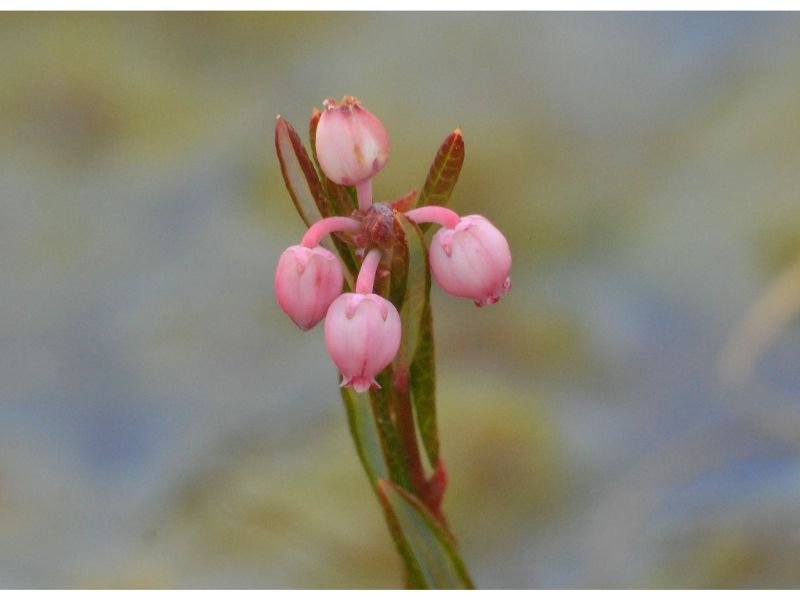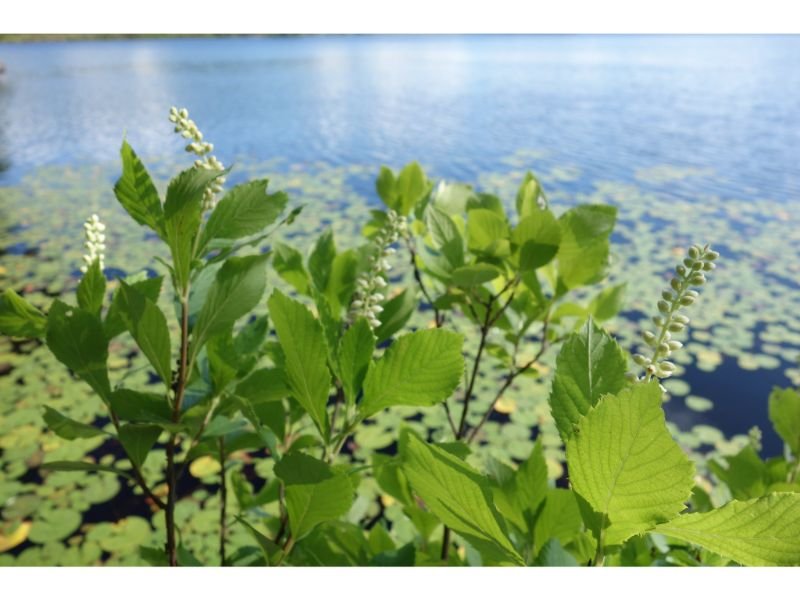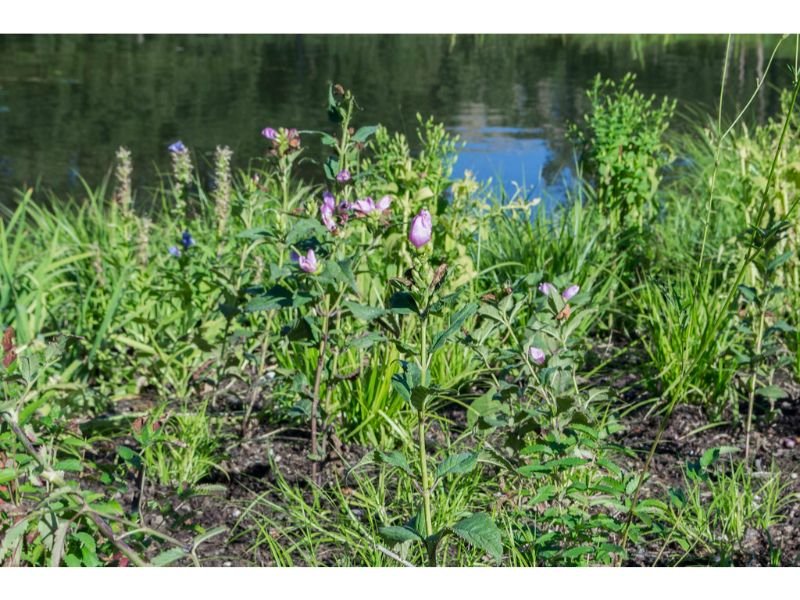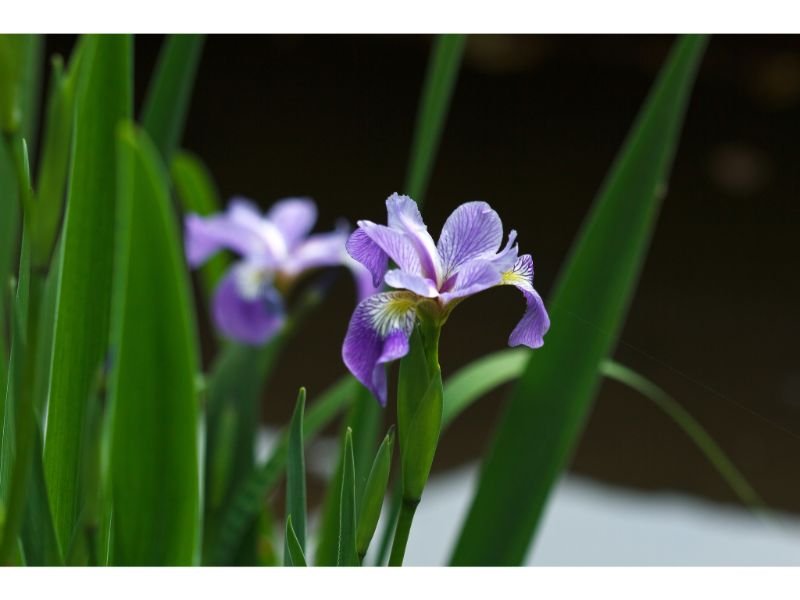The combination of consistently moist or waterlogged soil and the cold temperatures characteristic of zone 4 can make it difficult for many plants to thrive. But with careful plant selection and an understanding of the adaptations needed for wet environments, gardeners can find success in creating vibrant landscapes. In this section, we’ve gathered all the plants and shrubs for wet areas in Zone 4 to help you achieve that goal. So let’s check them out!

Table of Contents
Shrubs for Wet Areas Zone 4 and Shade
Bog Rosemary (Andromeda polifolia)

Plant Size: 1 to 2 feet high and wide
When it comes to the most suitable flowering plants and shrubs for wet areas in Zone 4, nothing can beat the audacity of bog rosemary. Not only does this plant thrive in a broad range of zones, but bog rosemary is also easy to maintain and is adapted to poor soil conditions.
Botanical Fun Fact
Bog rosemary plays an important role in wetland ecosystems. This small flowering shrub provides shelters and nesting sites for birds and small animals, thanks to its dense growth.
Red Osier Dogwood (Cornus sericea)

Plant Size: 6 to 8 feet high and 6 to 12 feet wide
Notable for their showstopper blood red stems, red osier dogwood shrubs are adaptable to a variety of humidity levels. They can be easily propagated through hardwood cuttings before the growing season begins. Generally, these shrubs for wet areas in Zone 4 hold value as ornamental plants for wildlife-themed gardens.
Botanical Fun Fact
Red osier dogwood shrubs can be used to stabilize soil and prevent erosion due to their extensive root system. Thus, they’re usually planted on slopes or along water bodies.
Summersweet (Clethra alnifolia)

Plant Size: 4 to 8 feet high and 4 to 6 feet wide
Summersweet are medium to large-sized flowering shrubs that prefer to grow in loam or sandy soil. Unlike red osier dogwood, they’re not programmed for dry environments and are more suited for humid zones. Applying a balanced, slow-release fertilizer in early spring can promote their growth.
Botanical Fun Fact
Summersweet shrubs feature fragrant blooms that can be described as sweet and spicy. These blooms are highly attractive to pollinators such as butterflies and hummingbirds.
Full Sun-loving Shrubs for Wet Areas Zone 4
Red Chokeberry (Aronia arbutifolia)

Plant Size: 6 to 8 feet high and 3 to 5 feet wide
These gorgeous shrubs are waiting for those looking for edible plants in wet areas in Zone 4. Red chokeberry shrubs have gained attention due to their berry-like fruits, which are rich in antioxidants, vitamins, and minerals.
Botanical Fun Fact
Red chokeberry offers stunning fall foliage display as it turns into shades of red, orange, and purple during this season.
False Indigo (Amorpha fruticosa)

Plant Size: 6 to 10 feet high and wide
Aside from wet soil, false indigo shrubs also thrive in acidic and alkaline soil. They’re not classified as invasive, however, they may occasionally experience leaf spot or powdery mildew diseases, more in overly humid and overcrowded conditions. The deep violet blooms of these shrubs for wet areas in zone 4 are one of their main charms.
Botanical Fun Fact
False indigo shrubs are nitrogen-fixation plants, which means they have symbiotic mutualism with nitrogen-fixing bacteria in their roots, converting the atmospheric nitrogen into a usable form.
Sweetfern (Comptonia peregrina)

Plant Size: 3 to 6 feet high and 6 to 8 feet wide
Although sweetfern makes it to the list of sun-loving shrubs for wet areas in Zone 4, these perennial shrubs can withstand shady areas and dry conditions. However, they still prefer to thrive in moist areas where regular watering is provided.
Botanical Fun Fact
Sweetfern shrubs are not true ferns. They’re part of the barberry (Myricaceae) family and nicknamed so due to their fern-like foliage and sweet, spicy mint aroma.
Plants for Wet Areas Zone 4 with Purple and Pink Flowers
Joe Pye Weed (Eutrochium purpureum)

Plant Size: 5 to 7 feet high and 2 to 4 feet wide
Not only humans, even butterflies, and caterpillars are amazed at how breathtaking joe pye weed is. This plant’s attractive flowers are one of the major pollinator-magnet. They’re typically hassle-free once established and adaptable to any humidity level and soil type, as long as it’s well-drained and humus-rich.
Botanical Fun Fact
Joe Pye weed has been associated with folklore and legends. In many cultures, this plant has been used to attract love as well as to bring good fortune and ward off evil spirits.
Pink Turtlehead (Chelone lyonii)

Plant Size: 2 to 3 feet high and 1 to 2 feet wide
Pink turtlehead is a dry and humid-friendly, humus-rich-fan plant that wouldn’t mind being grown next to almost any kind of shrub for wet areas in Zone 4. They typically bloom in late summer to early fall. Another plus thing to add is, pink turtlehead is also not known for being invasive, they’re well-behaved in garden settings!
Botanical Fun Fact
Pink turtlehead is resistant to deer browsing. The plant produces bitter compounds that make it unattractive for these herbivores.
Plants for Wet Areas Zone 4 with Yellow Flowers
Celandine Poppy (Stylophorum diphyllum)

Plant Size: 1 to 2 feet high and 1 to 1.5 feet wide
The Celandine poppy, as the name indicates, is a part of the poppy (Papaveraceae) family with attractive ornamental golden-yellow blooms. This non-invasive, shade-loving plant requires consistent hydration and is often found thriving from streams to mountain areas.
Botanical Fun Fact
Celandine poppy can self-seed, mostly in suitable growing conditions. The new plants are usually appearing near the parent plant.
Yellow Rocket (Barbarea orthoceras)

Plant Size: 1 to 3 feet high and 1 to 2 feet wide
The growing need for yellow rocket is minimal. Nonetheless, these flowering plants for moist areas of zone 4 may attract pests such as fleas, aphids, and cabbage worms, as well as fungal diseases like powdery mildew. Yellow rockets grow best from full sun to partial shade.
Botanical Fun Fact
The young foliage and blooms of yellow rocket are edible and can be used as a garnish. However, the taste is slightly bitter.
Plants for Wet Areas Zone 4 with Blue Flowers
Northern Blue Flag (Iris versicolor)

Plant Size:
Besides the previous plants and shrubs for wet areas in Zone 4, you can invite some scarcity and elegance to the challenging gardening bed by cultivating some northern blue flags. This plant is a big fan of soil with good organic matter and should remain consistently moist but not waterlogged.
Botanical Fun Fact
The northern blue flag is a wetland habitat that grows from underground rhizomes that spread horizontally. They’re highly valued for their coloration, which ranges from deep blue to violet blue.
Final Verdict
No matter where you live, don’t let the ‘harsh’ environments become obstacles to your love of plants. With this careful selection of plants and shrubs for wet areas in Zone 4, you can now turn the area into a source of beauty and enjoyment!

New author in the hood. Loves gardening and flowers are my spirit animals (yes I know they are not animals but I insist). I will be covering most of the flowers’ topics here and occasionally random though as well.






